
A sump can be a great addition to your tank and make your fishkeeping routine a lot less demanding.
However, is it essential for a saltwater or coral fish tank?
We take a look at sumps and how they work.
Do You Need a Sump for a Saltwater Tank?
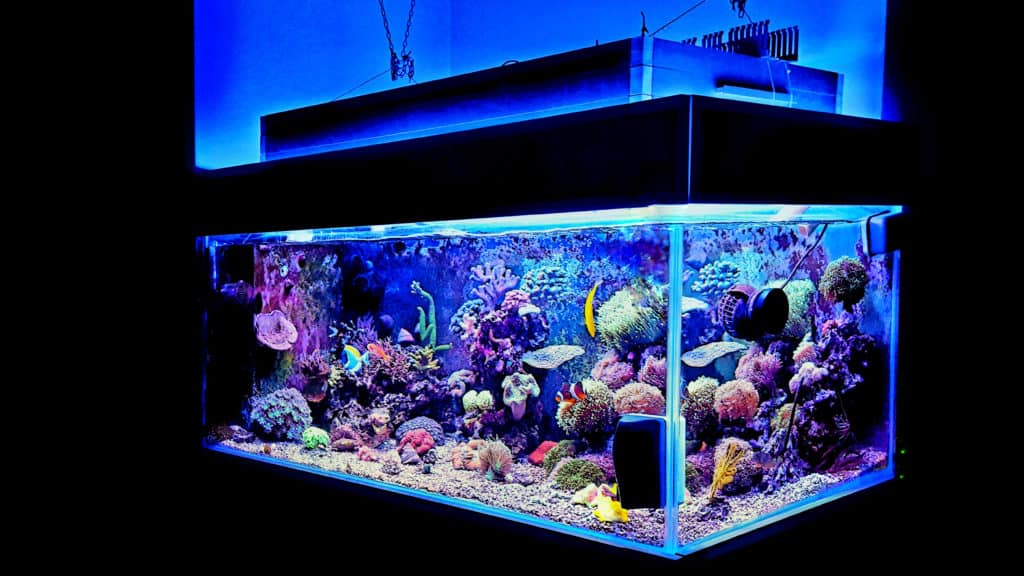
Many hobbyists strongly believe that a sump is a necessity for a saltwater aquarium.
However, we can see many beautiful aquariums thriving without one.
Installing a sump is entirely up to you.
Sumps give you more freedom when choosing the equipment for your tank.
They’re also easy to hide, which means you can create a realistic view.
A sump provides better filtration, increased water volume, and a better way to dose your aquarium with supplements.
Many sumps include a refugium which can filter your water naturally while feeding your fish.
You can run a sumpless saltwater fish tank by performing frequent water changes, adjusting a strong enough flow rate, and installing media reactors and protein skimmers.
What Is a Sump?
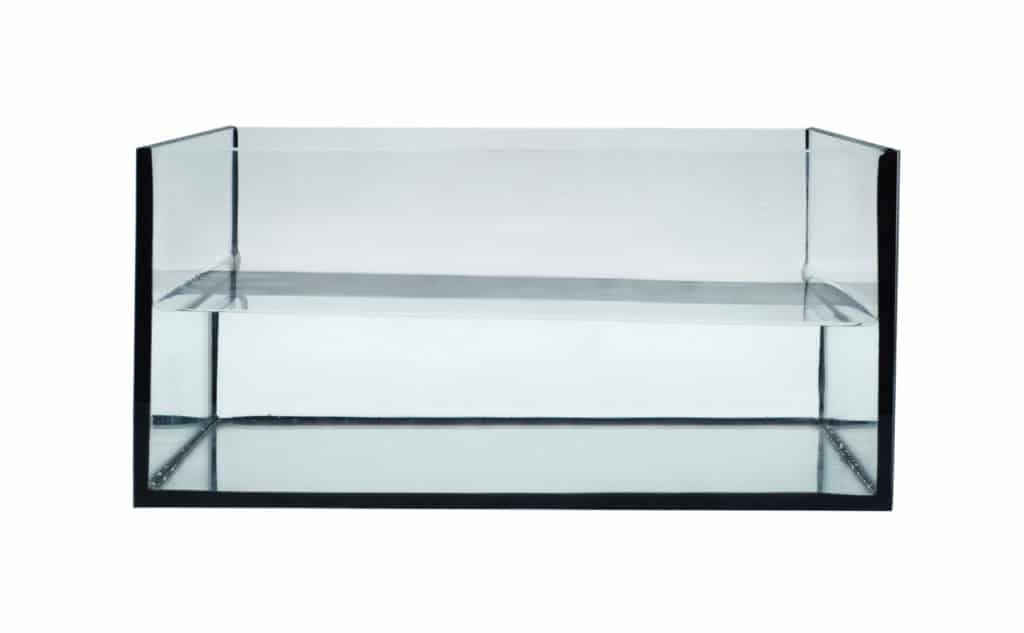
A sump is an additional tank or container outside the main or display tank.
It’s often made of glass or acrylic, and you can put it under or behind the main tank.
If you have a basement, you can set the sump in there without worrying about how much space it’ll take.
Depending on your tank’s needs and where you want to put the sump, it can have a simple structure or multiple purpose-built containers.
It contains water and other equipment of your choice.
These can include a filter, heater, protein skimmer, calcium reactor, refugium, chiller, phosphate removing reactor, automated top-off system, UV sterilizer, ozonizer, and other devices.
A sump lets you create an organized space for the functional part of your saltwater or reef tank while allowing the display tank to remain free of unnatural pumps and wires.
How Do Sumps Work?

The water drains from the main tank through the pipes and overflow box.
It then arrives at the sump and goes through the filter and other equipment.
It’s then pumped back up to the main tank through the “return pump”, making a closed-loop system.
You can adjust the flow rate of water and modify how much time it takes for complete circulation.
Benefits of Having a Sump

1. Hiding Equipment
Who doesn’t want their display tank to look neat and natural?
All the equipment and plumbing of a saltwater or reef tank can mess up the beautiful view of your aquarium.
Installing a sump is a great way to organize and hide the filter, heater, protein skimmer, media reactors, etc.
If you put the sump inside a cabinet or stand, you’ll have plenty of room for all the extra tools, devices, cables, and pipes.
2. More Water
A sump tank can add to the amount of water flowing through the system, which means more stable water parameters.
Plus, the water temperature doesn’t fluctuate quickly if a malfunction happens with the heater.
Harmful water contaminants like ammonia, nitrites, and nitrates are easier to manage in a larger water body.
Phosphates, magnesium, and calcium contents won’t build up quickly.
Also, with a more stabilized environment, you won’t have to worry as much about shocking or stressing your fish.
What’s more, you can fit more fish inside your aquarium without jeopardizing their health.
You have to consider the minimum space each species needs to feel safe, not aggressive or territorial.
Still, you won’t have to be concerned with cleaning up and removing the waste and debris as often.
Water quality and salinity will stay near optimal for longer.
3. Fewer Limitations
Larger tanks need larger equipment to stay healthy.
The bigger your tank, the harder it’ll be to find small and compact equipment which can hang on the aquarium’s back and handle the large quantity of water.
Organizing the devices in a sump can be the best way to go for tanks larger than 150 gallons.
4. Better Filtration
With a sump, you’ll have the space you need for a strong mechanical and chemical filter.
You can place chemical media into mesh bags or media reactors and hang them on the sump’s side or back.
It’s also easy to promote biological filtration by putting bio-media in the sump and increasing bacteria surface areas.
This way, you can create an excellent environment for more fish and plants.
5. Refugia
Some sumps have a dedicated section for a refugium, a natural filter for your aquarium.
Many people grow macroalgae in a refugium.
Macroalgae consume harmful constituents like phosphates, nitrates, and calcium while stabilizing the pH and leaving the water fresh and healthy.
They also consume light and carbon dioxide for photosynthesis and give off beneficial oxygen.
You can adjust the aquarium lighting system to turn on when the lights go out in the main tank so that the oxygen levels don’t drop.
Most macroalgae species usually grow very fast and take up space, making them bad inhabitants for the main tank.
Moreover, many hobbyists don’t like the sight of macroalgae overtaking every corner of their display tank.
That’s why you can grow them in the refugium and even use them as nutritious food for herbivorous fish.
Macroalgae create a great environment for small creatures like copepods and amphipods to grow and multiply.
These creatures usually don’t get a chance to build a big enough colony in the main tank because predators eat them.
They can mature and increase their population in the refugium.
Eventually, they’ll find their way to the main tank, becoming tasty snacks for your picky omnivore fish, invertebrates, and corals.
6. Dosing Supplements
You can dose your aquarium with additional supplements more safely using sump.
For example, you can top off your reef tank with lime water or calcium.
It’ll mix with the water and get to the main tank slowly.
Adding fresh water to the tank through the sump is also a common technique.
7. Auto Top-Off System
Installing an automatic water top-off system saves you the trouble of adding water to the tank every day.
When the water evaporates in a marine tank, it leaves salt behind, a dangerous substance for the fish.
Plus, some equipment only works when there’s enough water in the tank.
An auto top-off system has sensors which can detect when the water level has dropped in the sump, therefore adding RO water from the top-off water container.
8. Other Benefits
- A sump reduces water leakage through skimmers and filters.
- Protein tends to accumulate on the water surface, causing issues with light efficiency and gas exchange. With a sump, the water constantly overflows from the main tank, and it gets skimmed when it passes through filtration.
- The dissolved oxygen levels will increase as the water flows through the system and mixes with the air.
The Downsides of Having a Sump
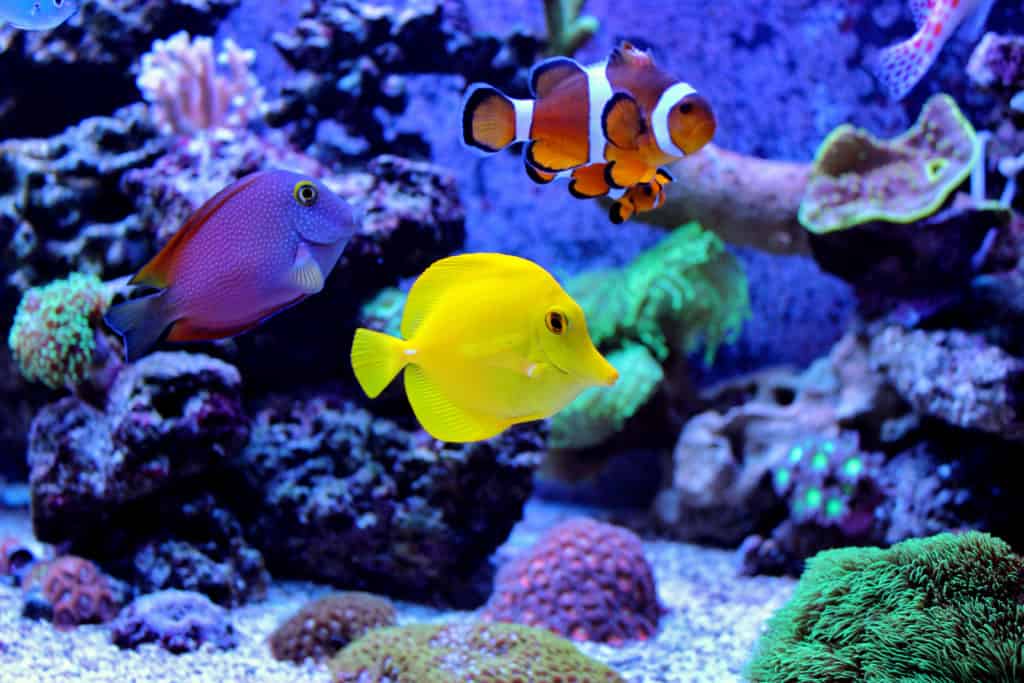
- As the pumps increase the water flow rate, bubbles start to form in the pipes and sump, increasing the main tank’s microbubbles.
- The additional return pump will cost you, and it uses up more electricity.
- The extra equipment you put in the sump can increase the water temperature.
- If the power goes out and you don’t have a back-up battery, the pump will stop working. Therefore, you’ll have to stop the water from overflowing from the sump manually.
- Some pumps need high water pressure to work, so they won’t be efficient if your water source is a well.
What You Need to Run a Saltwater Tank Without a Sump
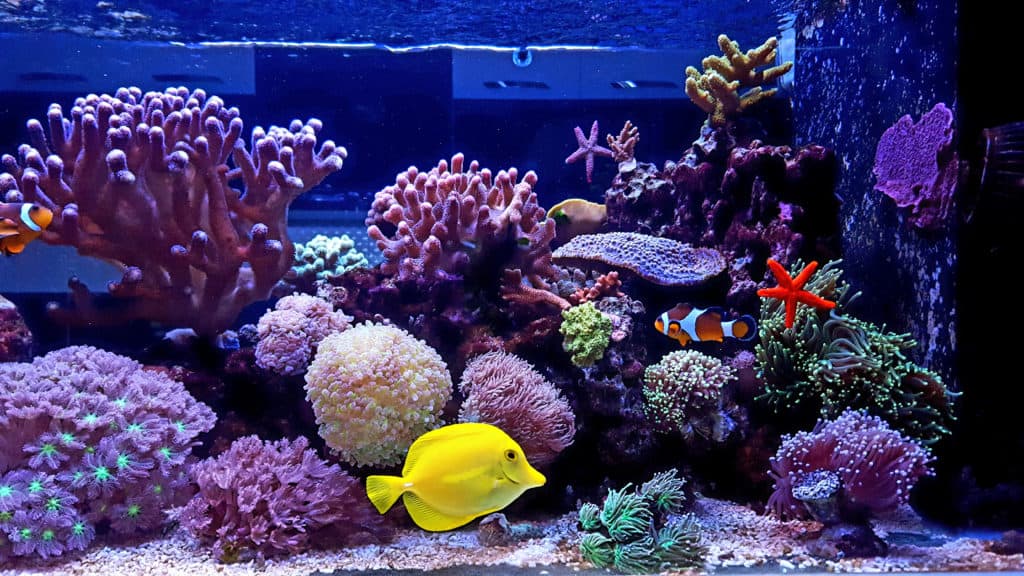
1. Water Changes
Fish produce waste every day.
Plants die and shed their leaves, debris forms, and sunken leftover food decays in the water.
All these natural events produce ammonia, nitrites, and nitrates.
To keep the tank clean without a sump, you need to scoop off the remaining food, vacuum the substrate regularly, remove dried leaves, and more importantly, do frequent water changes.
Water evaporates quickly, and if you don’t top it off, contaminant levels will rise.
As a result, algae blooms and bacterial blooms are more likely to occur.
The water could eventually become so dirty that your fish get sick and your corals close up.
Make sure that the fresh water you add to the tank is clean and as close as possible to the tank’s temperature.
RO water is best because it doesn’t contain harmful chemicals, heavy metals, and chlorine.
The amount and frequency of water changes will depend on the filter and how stocked your tank is.
A 20–25 percent water change is a good start.
2. Proper Flow
A sumpless tank should have proper water flow to stay healthy.
Without adequate water flow, waste can build up and decay, causing an ammonia or nitrite spike, which can burn the fish’s gills and ultimately kill them.
You need to install enough powerheads and air stones to create water flow and surface agitation.
This will also increase gas exchange, letting the CO2 get out.
Therefore, more oxygen can dissolve in the water.
3. Media Reactors
Incorporating a media reactor for your saltwater tank helps you maintain the conditions and water parameters without a sump.
Media reactors consist of two tubes that go in the tank, one pulling water to the reactor and the other pumping it back after refining.
The actual process in the reactor depends on the media you choose.
Considering what your tank needs, you can select one of these common media:
- Carbon: Activated carbon is the most popular media when it comes to fish keeping. It’s available in different porosity levels and sizes with a great absorption capacity. Carbon is an excellent water polisher, which clears toxins, impurities, unwanted chemicals, and foul odors, giving back crystal clear water.
- GFO (Granular Ferric Oxide): GFO is designed to filter out phosphates and silicates from the water. It helps you control algae growth and eliminates the outgrowth of hard corals. This filter media won’t leach back to the water.
- Bio Pellets: Bio pellets enhance the growth of beneficial bacteria and stabilize the nitrogen cycle while reducing the nitrate and phosphate levels. They also help with maintaining algae.
4. Protein Skimmers
Protein skimmers create a large air and water interface, which translates into producing thousands of microbubbles.
Organic waste will bond to the surface that the bubbles form.
This way, the protein skimmer can remove organic compounds such as proteins and amino acids leached by fish food.
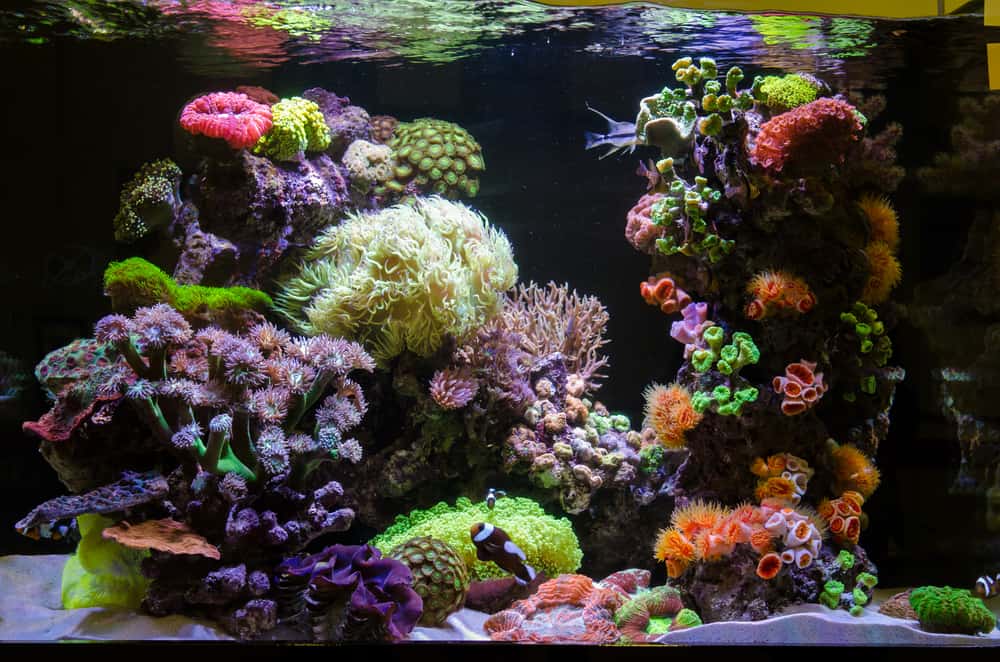
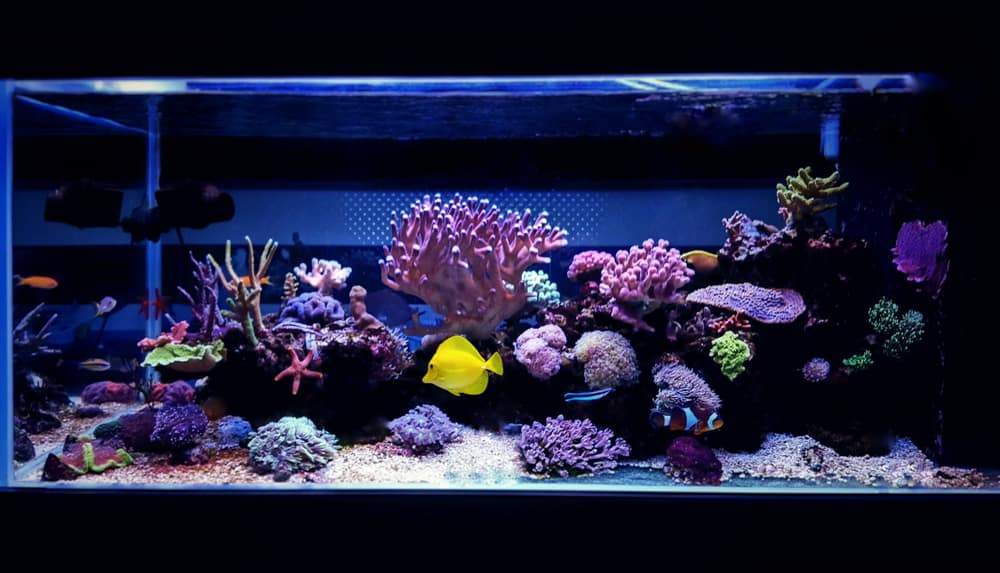

Leave a Reply
You must be logged in to post a comment.